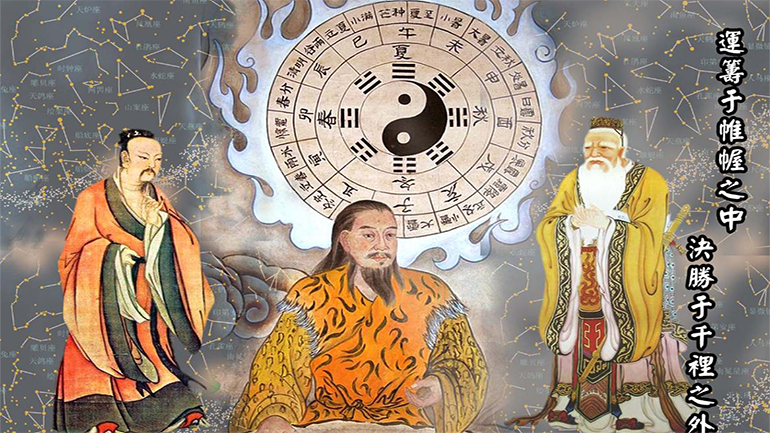
The Book of Changes (I Ching) is a book of knowledge and should be read as a "novel" in which the characters are made up of the hexagrams themselves. To let oneself be pervaded by the evoked images without attempting an analysis is the best way to approach it; the text must be understood both by means of rationality and by intuition, using the mind with its logical and analogical part, namely, Yang and Yin. Our study leads us to analyze all the expressive modes of the mind until we come to understand that the observer is not different from what is observed (and this is corroborated even by the recent discoveries of quantum physics).
Some philosophical considerations: We can say that perfection in form is a convention and as such "perfectible"; the perfection for the Chinese and the Indians lies rather in the absolute, in the inner consciousness, in the phase preceding each attribute. Hence the concept of indefinable and ineffable truth that can only be evoked and experienced in the dissolution of the individual subject in the universal subject.
Existence is an expression of the absolute that is neither understood nor described, but within the dualism it appears in the form of empirical knowledge of a subject who knows the object.
Our present research is based on the knowledge of the practical aspects of this dual manifestation, except to deny it from time to time to remind us that it is not the ultimate truth, this path is not learning to know what we are intimately, Absolute Consciousness, but there it serves above all to "detoxify" us from the externalizing tendency and from all that it produces (the sense of identification with form and name) because we want to give less value to this specific aspect. In reality, we analyze the outside (or the recognizable aspects of the mind) only in order to recognize its non-substantiality.
Reincarnation according to the Buddhist or Taoist concept is not personal.
The meeting of Yin with Yang leads to physical and psychical manifestation without this formative path being linked to the essence of an individual self; it is rather an expressive mode of consciousness that takes on a certain appearance and identity on the basis of the psychophysical characteristics in which it encounters.
In other words, the individual ego is only a mental tendency, a thought, an identifying capacity, which has no substance and is only a reflection that is formed in consciousness. Therefore according to the Buddhist criterion there is no individual self that is reincarnated but only a sequence of mental thoughts and tendencies in a sort of evolutionary continuation.
For this reason we point out the realization of Self as a "rediscovering" of what we have always been and not the achievement of something that we get from scratch, this "knowledge of self" and at the same time imponderable and indefinable and all-encompassing. The whole of everything that is.
Paolo D'Arpini
.jpg)
Testo italiano
Il Libro dei Mutamenti è un libro di conoscenza e andrebbe letto come un “romanzo” in cui i personaggi sono costituiti dagli esagrammi stessi. Lasciarsi pervadere dalle immagini evocate senza tentare un'analisi è il modo migliore per avvicinarsi ad esso; il testo va compreso sia per mezzo della razionalità che per mezzo dell'intuizione, usando cioè la mente con la sua parte sia logica che analogica ovvero Yang e Yin. Il nostro studio ci porta ad analizzare tutti i modi espressivi della mente fino ad arrivare a comprendere che colui che osserva non è diverso da quello che è osservato (e questo viene corroborato persino dalle recenti scoperte della fisica quantistica).
Alcune considerazioni filosofiche. Possiamo dire che la perfezione nella forma è una convenzione e come tale “perfettibile”; la perfezione per i Cinesi e gli Indiani risiede piuttosto nell'assoluto, nella coscienza interiore, nella fase che precede ogni attributo. Da qui il concetto di verità indefinibile ed ineffabile che può essere solo evocata e vissuta nello scioglimento del soggetto individuale nel soggetto universale.
L'esistenza è espressione dell'assoluto che non si comprende né si descrive, ma all'interno del dualismo appare in forma di conoscenza empirica di un soggetto che conosce l'oggetto.
La nostra ricerca presente è basata sulla conoscenza degli aspetti pratici di questa manifestazione duale, salvo il negarlo di tanto in tanto per ricordarci che non è la verità ultima, questo percorso non è di apprendimento per conoscere quello che intimamente siamo, Coscienza Assoluta, ma ci serve soprattutto per “disintossicarci” dalla tendenza esternalizzante e da tutto ciò che essa produce (il senso di identificazione con la forma ed il nome) perché vogliamo dare meno valore a questo aspetto specifico. In realtà analizziamo l'esterno (ovvero gli aspetti riconoscibili della mente) solo allo scopo di poterne riconoscere la non-sostanzialità.
La reincarnazione secondo il concetto buddista o taoista non è di tipo personale. L'incontro dello Yin con lo Yang porta alla manifestazione fisica e psichica senza che questo percorso formativo sia legato all'essitenza di un io individuale; si tratta piuttosto di un modo espressivo della coscienza che assume una determinata sembianza ed identità sulla base delle caratteristiche psicofisiche in cui si imbatte.
In altre parole l'io individuale è solo una tendenza mentale, un pensiero, una capacità identificativa, che non ha sostanza ed è solo un riflesso che si forma nella coscienza. Perciò secondo il criterio buddista non c'è alcun io individuale che si reincarna ma solo una sequenza di pensieri e tendenze mentali in una sorta di prosieguo evolutivo.
Per questa ragione si indica la realizzazione di Sé come un “ritrovare” ciò che si è sempre stati e non il raggiungimento di un qualcosa che si ottiene ex novo, questa “conoscenza di sé e allo stesso tempo imponderabile ed indefinibile ed onnicomprensivo. L'insieme di tutto ciò che è.
Paolo D'Arpini


Nessun commento:
Posta un commento
Nota. Solo i membri di questo blog possono postare un commento.